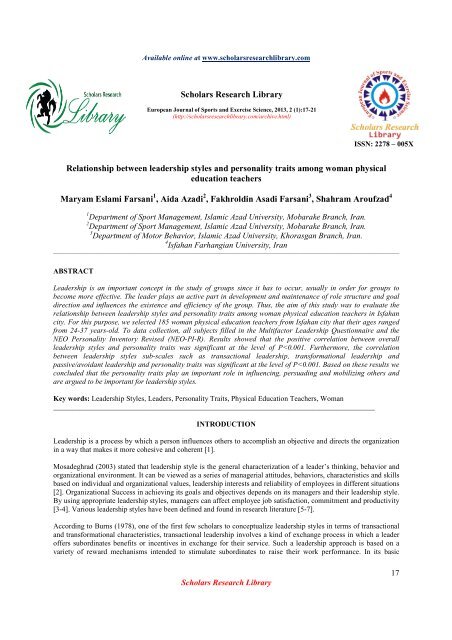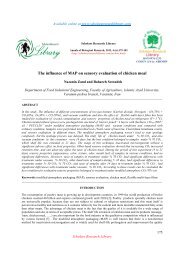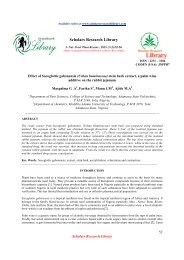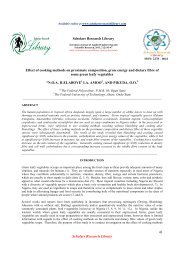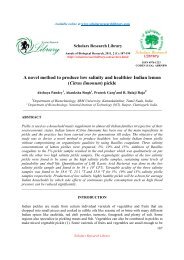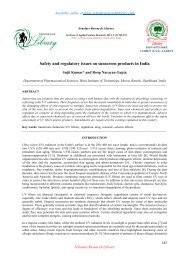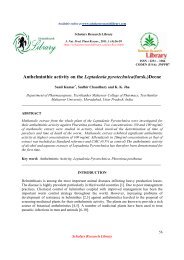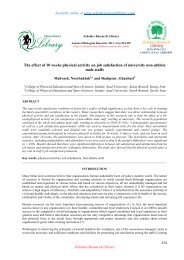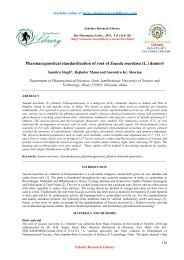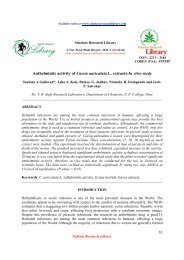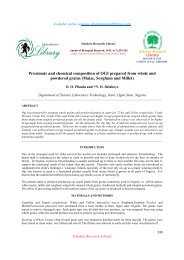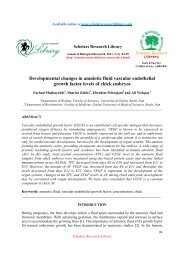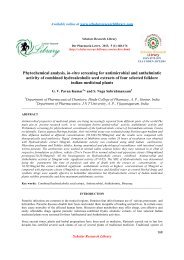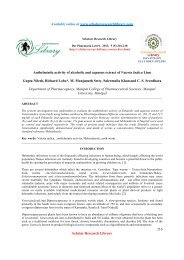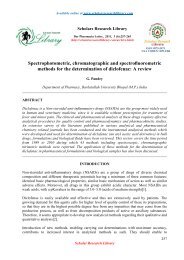Relationship between leadership styles and personality traits among ...
Relationship between leadership styles and personality traits among ...
Relationship between leadership styles and personality traits among ...
You also want an ePaper? Increase the reach of your titles
YUMPU automatically turns print PDFs into web optimized ePapers that Google loves.
Available online at www.scholarsresearchlibrary.com<br />
Scholars Research Library<br />
European Journal of Sports <strong>and</strong> Exercise Science, 2013, 2 (1):17-21<br />
(http://scholarsresearchlibrary.com/archive.html)<br />
ISSN: 2278 – 005X<br />
<strong>Relationship</strong> <strong>between</strong> <strong>leadership</strong> <strong>styles</strong> <strong>and</strong> <strong>personality</strong> <strong>traits</strong> <strong>among</strong> woman physical<br />
education teachers<br />
Maryam Eslami Farsani 1 , Aida Azadi 2 , Fakhroldin Asadi Farsani 3 , Shahram Aroufzad 4<br />
1 Department of Sport Management, Islamic Azad University, Mobarake Branch, Iran.<br />
2 Department of Sport Management, Islamic Azad University, Mobarake Branch, Iran.<br />
3 Department of Motor Behavior, Islamic Azad University, Khorasgan Branch, Iran.<br />
4 Isfahan Farhangian University, Iran<br />
________________________________________________________________________________________________________________________________________________<br />
ABSTRACT<br />
Leadership is an important concept in the study of groups since it has to occur, usually in order for groups to<br />
become more effective. The leader plays an active part in development <strong>and</strong> maintenance of role structure <strong>and</strong> goal<br />
direction <strong>and</strong> influences the existence <strong>and</strong> efficiency of the group. Thus, the aim of this study was to evaluate the<br />
relationship <strong>between</strong> <strong>leadership</strong> <strong>styles</strong> <strong>and</strong> <strong>personality</strong> <strong>traits</strong> <strong>among</strong> woman physical education teachers in Isfahan<br />
city. For this purpose, we selected 185 woman physical education teachers from Isfahan city that their ages ranged<br />
from 24-37 years-old. To data collection, all subjects filled in the Multifactor Leadership Questionnaire <strong>and</strong> the<br />
NEO Personality Inventory Revised (NEO-PI-R). Results showed that the positive correlation <strong>between</strong> overall<br />
<strong>leadership</strong> <strong>styles</strong> <strong>and</strong> <strong>personality</strong> <strong>traits</strong> was significant at the level of P
Maryam Eslami Farsani et al Euro. J. Sports Exerc. Sci., 2013, 2 (1):17-21<br />
______________________________________________________________________________<br />
practice, a leader guides <strong>and</strong> inspires subordinates in pursuit of established goals by clearly identifying the roles,<br />
task requirements, <strong>and</strong> effectiveness objectives. Another <strong>leadership</strong> approach is transformational <strong>leadership</strong> which<br />
deals with the <strong>leadership</strong> issue from a total different perspective or on another level of cognition [8]. A<br />
transformational leader has a profound influence on the followers <strong>and</strong> encourages them to place group benefits over<br />
individual interests [7-8]. Bass (1985, 1995) held that transactional <strong>leadership</strong> emphasizes the process in which a<br />
leader makes a commitment of reward exchange to subordinates. Therefore, the influence of transactional <strong>leadership</strong><br />
tends to happen when a leader makes a promise to the best interests of their subordinates [9-10].<br />
On the other h<strong>and</strong>, Personality <strong>traits</strong> are defined as consistent patterns of thoughts, feelings, or actions that<br />
distinguish people from one another [1, 11]. Also, Eslami Farsani et al. (2012) stated that 'the Big Five' is the<br />
commonly used term for the model of <strong>personality</strong> which describes the five fundamental factors of our <strong>personality</strong>. It<br />
combines the emotion, attitude <strong>and</strong> behavior of the people [11]. According to McCrae <strong>and</strong> Costa (1987), in this<br />
context there are five factor models which are extraversion, agreeableness, conscientiousness, neuroticism, <strong>and</strong><br />
openness to experience [12]. Furthermore, Judge & Bono (2000) in their research stated that extrovert’s people are<br />
social, assertive, active, brave, energetic, <strong>and</strong> adventurous. Individuals high on extroversion are dominant in their<br />
behavior <strong>and</strong> expressive when interacting with others. For example, people with social <strong>leadership</strong> skills are good at<br />
getting members of the team excited about their task, increasing energy, inspiring team spirit, <strong>and</strong> reducing conflict.<br />
Often, being a democratic type of <strong>leadership</strong>, social leaders often produce high performing teams <strong>and</strong> may be<br />
popular with their subordinates. In addition, people who are brave will not shy when they meet people. They are<br />
often full of energy <strong>and</strong> actively seek out attention from others. Extroverts are often competitive in nature <strong>and</strong> highly<br />
involved in many social circles <strong>and</strong> activities. Individuals scoring high on openness to experience are characterized<br />
by <strong>traits</strong> such as imagination, unconventionality, autonomy, creativity, <strong>and</strong> divergent thinking [13].<br />
McCrae <strong>and</strong> Costa (1987, 1992) argued that agreeableness is the individual who are altruistic, warm, generous,<br />
trusting, <strong>and</strong> cooperative. For example, an agreeable person is concerned with other interests. In addition,<br />
agreeableness can be a prerequisite to be able to underst<strong>and</strong> subordinates’ perspective <strong>and</strong> infuse their work with<br />
meaning. People who score high on the agreeableness scale show great compassion, cooperativeness, <strong>and</strong> empathy<br />
for all the members of society. They value being congenial with others <strong>and</strong> will go to great lengths to secure <strong>and</strong><br />
maintain their relationships. Agreeable people have an optimistic view on human nature <strong>and</strong> believe that people in<br />
general are honest <strong>and</strong> cooperative [12]. This altruistic view on life leads to them being involved in many social<br />
causes. Conscientiousness person encompasses dependability, responsibility, dutifulness, deliberation, achievement<br />
orientation, <strong>and</strong> a concern for following established rules [12-13]. This kind of person is very responsible with work<br />
<strong>and</strong> will be very careful to make a decision. This leads to conscientious people who are very organized,<br />
academically prepared <strong>and</strong> successful in a variety of situations [1].<br />
Also, McCrae <strong>and</strong> Costa (1987, 1992), neuroticism can be defined as the tendency to be anxious, defensive,<br />
insecure, <strong>and</strong> emotional. This means that neuroticism is associated with lack of self confidence. When the people<br />
lack confidence, they will always feel anxious, have a defensive attitude <strong>and</strong> feel insecure. For example, when the<br />
leaders ask him to make a decision, he will refuse to make a decision because he feels that the idea that he will<br />
express is irrelevant <strong>and</strong> he will also feel that the people will laugh at his idea. They are often easily disturbed or<br />
stressed by a variety of common situations leading them to express a negative emotion. This often leads to them<br />
experiencing normal interactions as threatening <strong>and</strong> trivial problems as impossibly difficult [12].<br />
In the context of <strong>leadership</strong> style, extroverts’ <strong>personality</strong> is important for transformational <strong>leadership</strong>. Bass (1985)<br />
stated that such characteristics play an important role in influencing, persuading <strong>and</strong> mobilizing others <strong>and</strong> are<br />
argued to be important for transformational leaders. With the charisma that the leaders have, leaders can convince<br />
people about the vision that he have <strong>and</strong> inspire or persuade the followers to look at the vision [10]. The suggestion<br />
fully supports Bono <strong>and</strong> Judge (2000) who found extraversion to be the strongest <strong>and</strong> most consistent <strong>personality</strong><br />
correlate of transformational <strong>leadership</strong> [13]. Thus, based on these evidences that presented, the aim of this study<br />
was to evaluate the relationship <strong>between</strong> <strong>leadership</strong> <strong>styles</strong> <strong>and</strong> <strong>personality</strong> <strong>traits</strong> <strong>among</strong> woman physical education<br />
teachers in Isfahan city.<br />
MATERIALS AND METHODS<br />
This study was the correlation study decision. Participants were included 185 woman physical education teachers<br />
from Isfahan city <strong>and</strong> their ages ranged from 24-37 years-old.<br />
Scholars Research Library<br />
18
Maryam Eslami Farsani et al Euro. J. Sports Exerc. Sci., 2013, 2 (1):17-21<br />
______________________________________________________________________________<br />
Instruments<br />
To data collection, all subjects filled in the Multifactor Leadership Questionnaire <strong>and</strong> the NEO Personality Inventory<br />
Revised (NEO-PI-R). Furthermore, to be more comprehensive, this study was using full-range of <strong>leadership</strong> <strong>styles</strong><br />
evolved by Bass <strong>and</strong> Avolio (2004) that consist of transactional <strong>leadership</strong>, transformational <strong>leadership</strong> <strong>and</strong><br />
passive/avoidant <strong>leadership</strong> [14]. The NEO Personality Inventory Revised (NEO-PI-R) was used to measure the<br />
<strong>personality</strong> of teacher physical education. This questionnaire divided to five sub-scales included neuroticism,<br />
openness to experience, extraversion, agreeableness, <strong>and</strong> conscientiousness.<br />
Also, questionnaire reliability with Cronbach's alpha for Multifactor Leadership Questionnaire <strong>and</strong> the NEO<br />
Personality Inventory Revised (NEO-PI-R) were obtained 0.87 <strong>and</strong> 0.94, respectively. The collected data was<br />
analyzed by descriptive (mean <strong>and</strong> st<strong>and</strong>ard deviation) <strong>and</strong> inferential (Pearson's correlation test <strong>and</strong> Cronbach's<br />
alpha) statistical tests at the P
Maryam Eslami Farsani et al Euro. J. Sports Exerc. Sci., 2013, 2 (1):17-21<br />
______________________________________________________________________________<br />
the elements that transformational leaders must have is individualized considerations. This kind of leader will<br />
encourage the followers to express new idea <strong>and</strong> trust the follower to make a decision. Judge <strong>and</strong> Bono (2000) found<br />
that openness to experience was associated with transformational <strong>leadership</strong>, because they are creative, individuals<br />
high in openness to experience are likely to score high in intellectual stimulation [15].<br />
Many studies which are conducted on <strong>personality</strong> <strong>and</strong> its correlation with <strong>leadership</strong> <strong>styles</strong> show the interaction<br />
<strong>between</strong> <strong>personality</strong> <strong>and</strong> behavior [16]. Costa <strong>and</strong> McCrae (1988) stated that the extraversion is related to social<br />
<strong>leadership</strong> [17]. In addition, Judge & Bono (2000) in their study found that the extraversion <strong>and</strong> agreeableness are<br />
predictors of transformational <strong>leadership</strong> [13]. Some researches prove that high agreeableness trait shows several<br />
<strong>leadership</strong> behaviors because they are interested for their own <strong>and</strong> other’s growth <strong>and</strong> development needs [9-10].<br />
Judge <strong>and</strong> Bono (2000) linked openness to experience with transformational <strong>leadership</strong>. Those who score high in<br />
openness to experience are intellectual [13]. After going through literature it is proved that there is no such research<br />
about teacher’s <strong>personality</strong> <strong>traits</strong> <strong>and</strong> influence on their <strong>leadership</strong> <strong>styles</strong>. There are many researches which show corelational<br />
analysis of <strong>personality</strong> <strong>traits</strong> <strong>and</strong> <strong>leadership</strong> <strong>styles</strong> of managers. Much work is done on head teacher’s<br />
<strong>leadership</strong> <strong>styles</strong>, women <strong>leadership</strong>, teacher’s <strong>leadership</strong> <strong>and</strong> student learning [18-19].<br />
Generally, when the leader is creative, he/she can transform people <strong>and</strong> organization to drive to the vision that he<br />
inspire. He/she will encourage followers to express the idea on how to solve the problem that organization face.<br />
Accordingly, Ployhart et al. (2001) found that openness to experience explained variance in transformational<br />
<strong>leadership</strong>, but only in more challenging conditions. According to Judge <strong>and</strong> Bono (2000) who found that openness<br />
to experience was associated with transformational <strong>leadership</strong>, because they are creative, individuals high in<br />
openness to experience are likely to score high in intellectual stimulation [13].<br />
The findings of the present study largely supported the conceptualization of <strong>leadership</strong> <strong>styles</strong> in terms of the full<br />
range model of <strong>leadership</strong>. The <strong>leadership</strong> <strong>styles</strong> practiced was associated with <strong>personality</strong> <strong>traits</strong> <strong>and</strong> behaviors<br />
relevant to the descriptions of these <strong>styles</strong> [20]. In summary, the managers who used a transformational style<br />
indicated <strong>personality</strong> <strong>traits</strong> associated with this type of <strong>leadership</strong>. Average to high scores in terms of strategic<br />
thinking, a conceptual <strong>and</strong> innovative approach, <strong>and</strong> critical evaluation of information were coupled with moral<br />
concerns, a sense of responsibility, <strong>and</strong> perseverance. These managers also showed at least reasonable resilience as<br />
well as ambition <strong>and</strong> motivation. Regarding the interpersonal aspect of <strong>leadership</strong>, this group indicated assertiveness<br />
<strong>and</strong> a need to influence others while also allowing participation by associates <strong>and</strong> involving others in decision<br />
making. These managers were characterized by a need for affiliation, responsiveness in interaction, trust in <strong>and</strong><br />
tolerance towards others as well as being reasonably caring. The manifestation of these <strong>traits</strong>, however, was<br />
influenced by their use of transactional <strong>leadership</strong>. They seemed more task oriented than people oriented, <strong>and</strong> their<br />
need for structure probably also affected the inspirational aspect of <strong>leadership</strong>. One of the managers in this group did<br />
not in all aspects fit the above profile <strong>and</strong> his <strong>personality</strong> characteristics corresponded to some extent with that of the<br />
second group. Although the people who rated him observed much of his behavior as transformational, this was not<br />
always supported in terms of the expected <strong>personality</strong> <strong>traits</strong>. For fear of over interpretation only a tentative<br />
explanation is provided, namely, that his lower post level implied raters at a lower post level who might have<br />
evaluated <strong>leadership</strong> behavior differently.<br />
REFERENCES<br />
[1] Noordin Yahaya, Mohammad Aslan B, Mohammad Taib, Jasmi Ismail1, Zainudin Shariff, Azizi Yahaya, Yusof<br />
Boon & Sharin Hashim. African Journal of Business Management, 2011, Vol. 5(22), pp. 9635-9648.<br />
[2] Mosadeghrad A.M. Principles of Health Care Administration. Dibagran Tehran, Tehran. 2003. Pp: 230-233.<br />
[3] Mosadeghrad AM, Yarmohammadian MH. Leadership Health Serv., 2006, 19 (2): 11-28.<br />
[4] Ming-Ten Tsai1, Chung-Lin Tsai2 <strong>and</strong> Yi-Chou Wang. African Journal of Business Management, 2011, Vol.<br />
5(13), Pp. 5319-5329.<br />
[5] Hirtz PD, Murray SL, Riordan CA. Eng. Manage. J., 2007, 19(1): 22-27.<br />
[6] House R, Hanges P, Javidan M, Dorfman P, Gupta V. Culture, <strong>leadership</strong>, <strong>and</strong> organizations. Beverly Hills, CL:<br />
Sage Publications Inc. 2004. Pp: 36-40.<br />
[7] Huang Q, Davison RM, Liu H, Gu J. J. Global Inform. Manage., 2008, 16(4): 67-91.<br />
[8] Burns JM. Leadership. New York: Harper. 1978. Pp: 3-4.<br />
[9] Bass B, Avolio BJ . MLQ Multifactor Leadership Questionnaire Second Edition Sampler Set: Technical Report,<br />
Leader Form, Rater Form, <strong>and</strong> Scoring Key for MLQ Form 5 Short. Mind Garden, Inc. California. 1995. Pp: 1-3.<br />
Scholars Research Library<br />
20
Maryam Eslami Farsani et al Euro. J. Sports Exerc. Sci., 2013, 2 (1):17-21<br />
______________________________________________________________________________<br />
[10] Bass BM. Leadership <strong>and</strong> performance beyond exceptions. New York: Free Press. 1985. Pp: 23-28.<br />
[11] Maryam Eslami Farsani1, Shahram Aroufzad, & Fakhrodin Asadi Farsani. European Journal of Experimental<br />
Biology, 2012, 2 (6):2140-2144.<br />
[12] Costa PT Jr., McCrae RR. Revised NEO Personality Inventory (NEO-PI-R) <strong>and</strong> NEO Five-Factor (NEO-FFI)<br />
Inventory Professional Manual. Odessa, FL: PAR. 1992. Pp: 121-129.<br />
[13] Judge TA, Bono JE. J. Appl. Psychol., 2000, 85(5): 751-765.<br />
[14] Bass, B. M., & Avolio, B. J. Multifactor Leadership Questionnaire: Manual <strong>and</strong> Sampler Set., 3 ed . Mind Garden<br />
Inc. 2004, 211-220.<br />
[15] Bono, J.E., & Judge, T.A. Journal of Applied Psychology, 2004, 89, 901-910.<br />
[16] Larsen, R.J., & Buss, D.M. Personality Psychology – Domains of knowledge about human nature, (2nd ed.).<br />
McGraw-Hill, New York. 2005. Pp: 24-25.<br />
[17] Costa, P. T., Jr., & McCrae, R. R. Journal of Personality <strong>and</strong> Social Psychology, 1988, 54, 853–863.<br />
[18] Yildirim, Osman, Acar, Ahmet Cevat, Educational Psychology, 2008, 28:1, 73 – 81.<br />
[19] Paunonen, S.V. Journal of Personality <strong>and</strong> Social Psychology, 2003, 84, 411-424.<br />
[20] René van Eeden, Frans Cilliers & Vasi van Deventer South African Journal of Psychology, 2010, 38(2),<br />
Pp.253-267<br />
Scholars Research Library<br />
21


